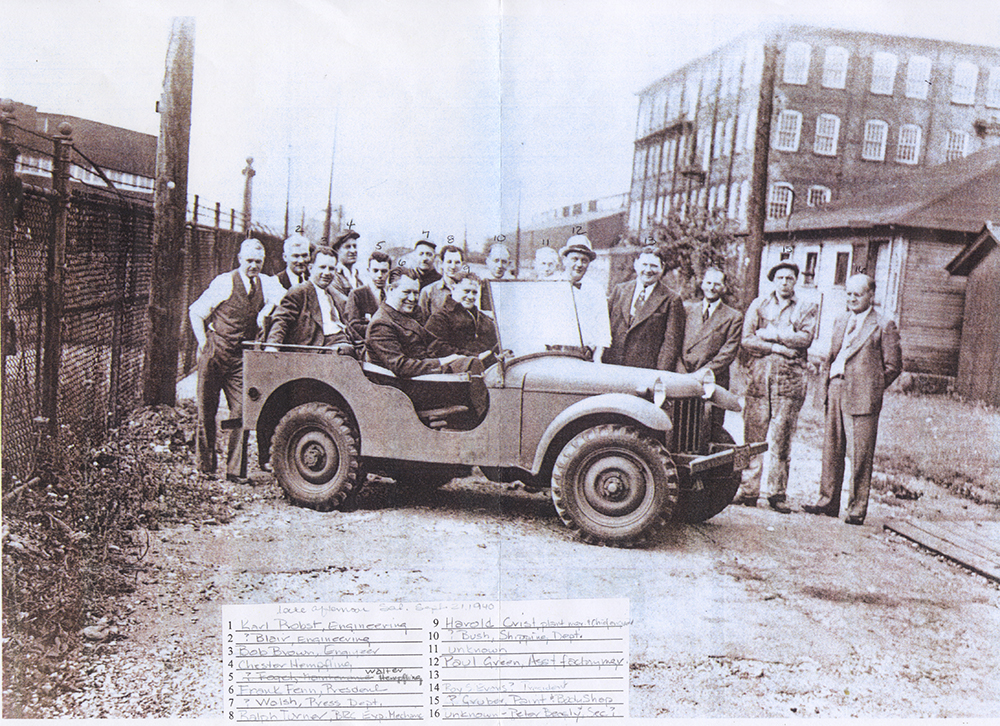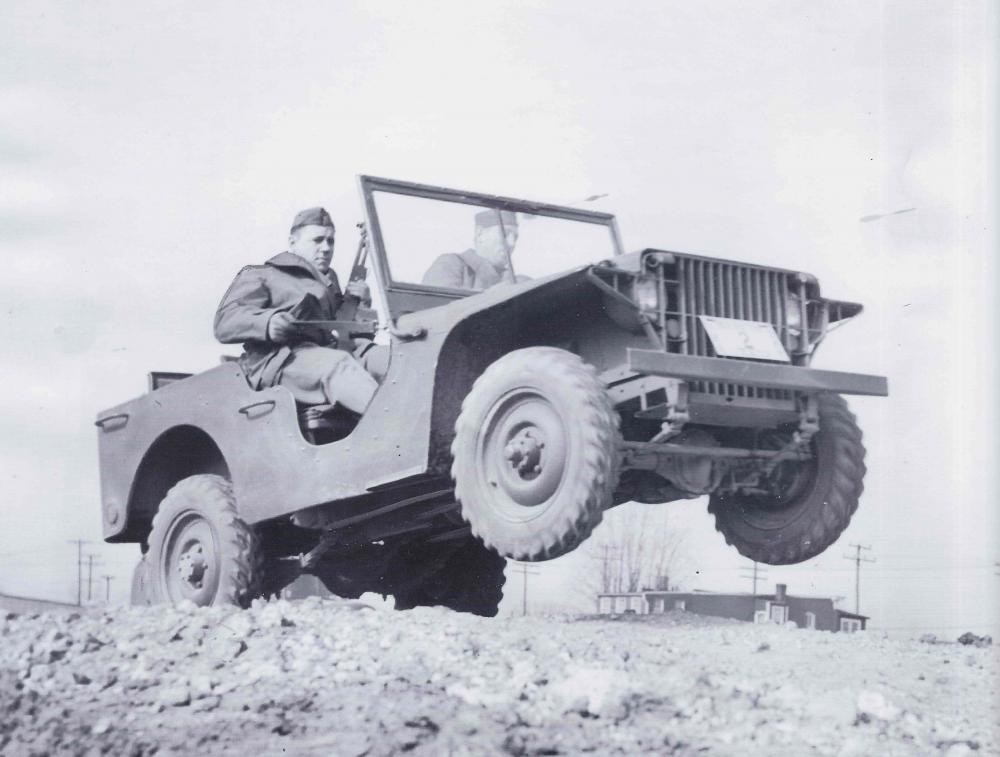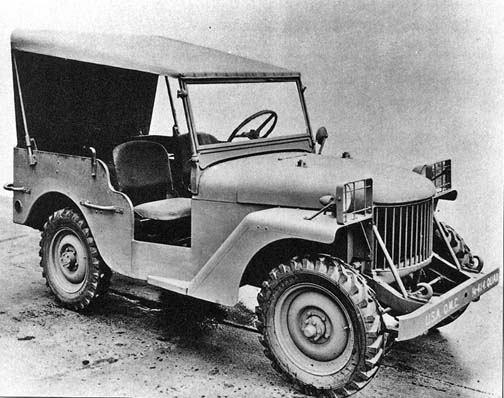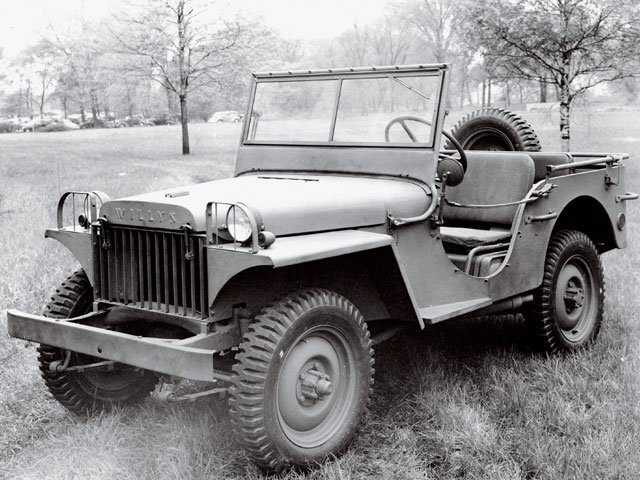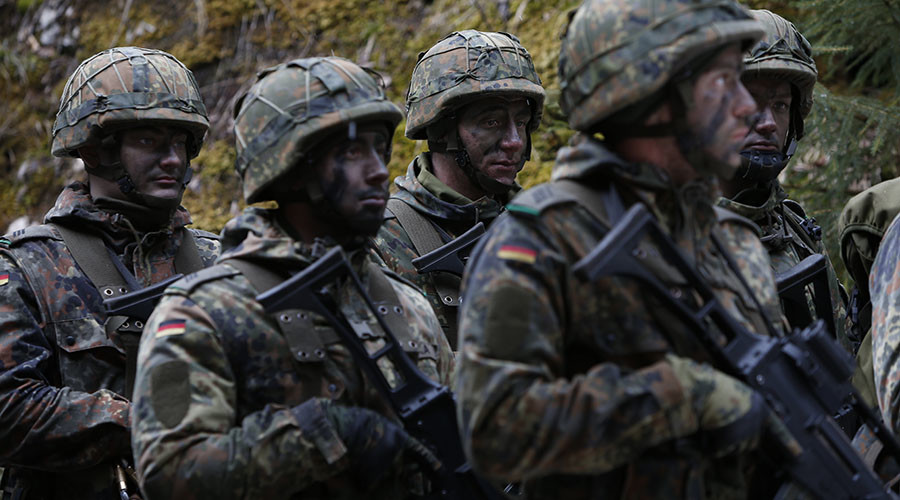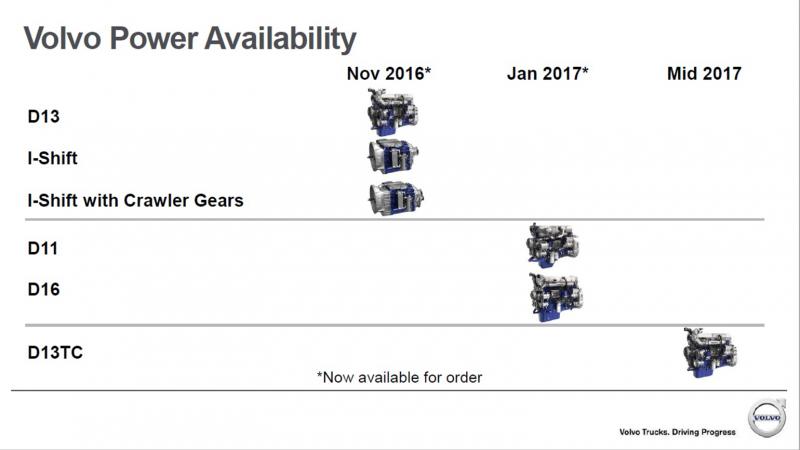
kscarbel2
Moderator-
Posts
18,868 -
Joined
-
Days Won
114
Content Type
Profiles
Forums
Gallery
Events
Blogs
BMT Wiki
Collections
Store
Everything posted by kscarbel2
-
Badge of Honor: Jeep's heroic 75-year campaign
kscarbel2 replied to kscarbel2's topic in Odds and Ends
The industry's most copied brand Richard Truett, Automotive News / July 11, 2016 Jeep inspired Land Rovers, Land Cruisers, Broncos and Scouts Jeep can claim many milestones. But here's one you may not have thought of: It's the most copied brand of American vehicles. The World War II military Jeep -- the forerunner of today's Wrangler -- spawned the Land Rover in 1948 and, in the early 1950s, Toyota's BJ and FJ, which morphed into the Land Cruiser. Later the civilian Willys Jeep CJ series was the inspiration for all other competitors, from the International Scout and Ford Bronco of the 1960s to the Suzuki Samurai and Daihatsu Rocky of the 1980s. Then there's the 1984 Jeep Cherokee XJ -- the first unibody SUV -- which is the template for the modern SUV and has been copied universally. Early competitors tore apart the military Jeeps while creating their own versions. The first Land Rover prototype, built in 1947, had a Jeep chassis. In the book Land Rover: The Unbeatable 4X4, authors Ken and Julie Slavin document the creation of the first Land Rover, which over the years has proved to be the Jeep's toughest competitor. "Using the Willys Jeep as a jumping off point, the design team had to scrutinize every detail of the American product and drive it in all possible conditions to learn its limitations," the Slavins wrote. "Two Jeeps were acquired early on, solely for dissection purposes, but although certain of its stronger points were without doubt copied in the Land Rover, the Rover team maintained vehemently that there was nothing on the Land Rover that corresponded exactly to the Jeep." Today, the Wrangler, with its fold-forward windshield, exposed hinges, round headlights and other design cues, has no real competition. But the same cannot be said for all the other vehicles in the Jeep lineup, especially the Grand Cherokee, which traces its DNA back to the 1984 Jeep Cherokee and slugs it out in one of the most competitive market segments. Roy Lunn, Jeep's former director of engineering, led the team in the early 1980s that created the XJ. Lunn said the inspiration for the unibody SUV came from the fuel shocks of the 1970s. "Other companies didn't do it by choice. They said, "We'll make an SUV-type vehicle and what is the nearest vehicle to base it on?' They chose their light truck to derive it from. But the light truck line had a separate frame and normal heavy construction," Lunn said. "I chose unitized because it is stronger pound for pound and it is lightest for meeting fuel economy requirements." -
Badge of Honor: Jeep's heroic 75-year campaign
kscarbel2 replied to kscarbel2's topic in Odds and Ends
Why it's a 'Jeep' and not a 'Leaping Lena' Larry P. Vellequette, Automotive News / July 11, 2016 Name's mysterious origins may trace back to Ford It's one of the eternal mysteries surrounding Jeep: Where does the name come from? There is no shortage of theories. Was the name in homage to a character in the "Popeye" comic strip from the 1930s or perhaps the pronunciation of the acronym for General Purpose? Some suggest it was a soldier's acronym for Just Enough Essential Parts. In his book Jeep: The History of America's Greatest Vehicle, Patrick R. Foster says the name came from veteran Willys test driver Red Hausmann. In February 1941, Hausmann was driving journalist Katharine Hillyer in one of the early prototypes of the Willys Quad across some extremely steep hills when she asked the name of the vehicle. In her story, Hillyer quoted Hausmann saying, "It's a Jeep." But one explanation that would seem to have a lot of credibility is that the name originated at Ford Motor Co., which built about 277,000 Jeeps during World War II. Ford's nomenclature for its vehicles used GP as the two-letter code for the Ford Pygmy, its entrant in the Army's request for bids to build a reconnaissance vehicle. When Ford was awarded a contract in October 1941 to build the approved Willys-Overland versions, it stamped those vehicles as GPW (GP-Willys). The magazine Scientific American published a full review of the military's new wonder buggy in its January 1942 issue. The author of that review, journalist Jo Chamberlin, had visited an Army base in Louisiana in September 1941 to try out the military's new "midget combat car" and came away duly impressed. Chamberlin made two mentions of the origin of the name, writing: "Our Army's youngest, smallest toughest baby has a dozen pet names such as jeep, peep, blitz-buggy, leaping Lena, panzer-killer. The names are all affectionate, for the jeep has made good. Only a year old, it stole the show in Louisiana. Now the Army plans to have 75,000 of them." In a prescient footnote, Chamberlin wrote: "Some army men call the bantam a "peep,' reserving "jeep' for the larger command car in which the brass hats ride. However, the term "jeep' (born of GP, an auto manufacturing classification) is used by newspapers and most soldiers, and apparently will stick." -
Badge of Honor: Jeep's heroic 75-year campaign
kscarbel2 replied to kscarbel2's topic in Odds and Ends
The engine that drives FCA Larry P. Vellequette, Automotive News / July 11, 2016 Jeep barrels into global markets In its 75-year history, Jeep never has been in better shape than it is right now. The reason? Current owner Fiat Chrysler Automobiles has accomplished what a succession of previous owners only dreamed of: truly globalizing one of the world's most storied automotive brands. Worldwide, Jeep's deliveries in 2015 topped 1.2 million vehicles, its fourth consecutive record year for global production and sales. Jeep Renegades are now built in Europe (Italy), South America (Brazil) and Asia (China) for sale in those regional markets. By the end of the year, production of the replacement for the Jeep Compass will begin in Brazil and China, as well as Mexico. Jeep-branded vehicles also will soon begin rolling into India, with local production slated to begin in 2017. Meanwhile, sales in Jeep's largest and most profitable market, the United States, are up 17 percent through June over record 2015 sales. Jeep's lineup also is expanding. Brand head Mike Manley said last month that luxury full-size SUVs under the storied Wagoneer and Grand Wagoneer names will return with the development of a redesigned Jeep Grand Cherokee in 2019. On the other end of the size spectrum, a micro-segment Jeep, smaller than the Renegade, is under strong consideration, primarily for markets outside North America. Meanwhile, FCA is expanding production capacity of its profit-rich Wrangler by at least 50 percent, allowing the brand to fulfill what it sees as unmet domestic and international demand. The added capacity also will allow for the return of a pickup to the Jeep lineup for the first time since 1996. CEO Sergio Marchionne says Jeep is the engine that keeps his company going, no matter how tough the economic circumstances become. "One of the things that we've always faced in the United States in the production of Jeeps is to make this unfortunate Sophie's Choice about whether we sell in the U.S. or whether we sell overseas," Marchionne explained this year. "In the last probably three or four years especially, we've been forced to make choices about which markets get allocated product. "Even if there were to be a contraction of the U.S. market, there is unexplored potential in terms of outside U.S. markets, especially where we have not established local production," he said. "Anything which relates to either a Cherokee or a Grand Cherokee and eventually a Wagoneer or Wrangler will have additional means of expression in international markets." -
Larry P. Vellequette, Automotive News / July 11, 2016 Vehicles stormed through war and battles that followed Not much that is truly groundbreaking in this world was created by committee. Innovation simply doesn't work that way. But in the automotive realm, we have one giant exception, and it is Jeep -- a vehicle forged in the crucible of war that grew into one of the world's most recognized brands, automotive or otherwise. Jeep is celebrating the 75th anniversary of the brand this week. The birth of Jeep is a complicated story that is subject to many interpretations. But on July 16, 1941, Willys-Overland Motor Co., of Toledo, Ohio, received the first contract to produce the Willys MB for use by the American military. A public celebration will follow next month, but this weekend, thousands of Fiat Chrysler workers in Toledo will gather for a private company picnic to commemorate the beginnings of the brand. Jeep's early history is legendary. Its role in helping defeat the Axis powers during World War II is undeniable. On the battlefield, the Jeep was fast, nimble and tough. It could handle nearly any terrain, and when it did get stuck, it was light enough for soldiers to lift free. It towed anti-tank weapons that could be deployed quickly, and it could mount a machine gun for fighting infantry. The Jeep also served as an ambulance on the battlefield. It forded rivers and traversed lakes, it came ashore on D-Day, and it carried the Allies all the way to Berlin and onto Guadalcanal and Iwo Jima and, eventually, onto the mainland shores of a defeated Japan. But Jeep's postwar life has been a decades long trail of both rousing successes -- and abject failures. One weak corporate owner after another failed, yet Jeep has soldiered on. Today, Jeep carries Fiat Chrysler Automobiles as the automaker struggles to compete with more powerful, profitable global competitors. Prewar baby Jeep had a complicated birth, and much controversy remains about its origin. But some facts are undisputed. As World War II began to ravage Europe and Asia, the War Department realized the armed forces needed a small reconnaissance vehicle. It put out requests for proposals to U.S. automakers on an extremely aggressive timetable. Initially, only two poorly financed small-car specialists responded: American Bantam Car Co., of Butler, Pa., and Willys-Overland, of Toledo, Ohio. The first prototype military Jeep was developed by Bantam. Designed in 18 hours by Karl Probst, a freelance auto designer from Detroit, the 1,840-pound Bantam exceeded the Army's expectations during initial testing in September 1940. The War Department, however, had concerns about Bantam's ability to meet the military's capacity needs. As a result, it invited Willys-Overland and Ford Motor Co. to bid on the reconnaissance vehicle contract, this time using Probst's design as a guidepost and allowing engineers from the two automakers to inspect and measure the Bantam. Each automaker crafted a vehicle that was intended to meet the War Department's specifications -- but with varying success. The Willys Quad had the most powerful engine -- the 60-hp Go Devil four-cylinder, which gave it a significant power advantage. The Ford Pygmy had superior craftsmanship, and it featured a flat hood and flat fenders that the War Department judged as useful improvements. The Bantam, now updated from its original design, was the lightest and most fuel-efficient. After conducting rigorous testing in Maryland, the War Department sought final bids and awarded the first production contract to Willys-Overland. A second production contract for the same design later was awarded to Ford to meet demand. More than 637,000 Jeeps were built by Willys and Ford during World War II, while Bantam was awarded a contract to build quarter-ton trailers that were pulled behind the MB. Even today, remnants of Jeep's birth by committee exist on the MB's descendent, the Jeep Wrangler. For example, the "T" latches still used to hold down the hood were a Ford innovation, as was the single-piece, stamped slotted grille with round headlights that Jeep also uses as a logo. Civilian Jeeps Jeep's wartime history is well-documented, but the transition to civilian life is less so. As World War II began to wind down, Willys executives began thinking about the Jeep's postwar existence. It didn't have to look far for a design. Willys took the MB and modified it, improving the headlights and seats and giving it a tailgate. The production version became the Willys CJ-2A. It also introduced other innovative vehicles, including the 1946 Willys Station Wagon -- the first such station wagon to be built completely of steel -- and the 1947 Jeep pickup. The company had two secret weapons, argues Patrick Foster, author of four books on Jeep, including 2014's Jeep: The History of America's Greatest Vehicle. "Willys-Overland had always had a policy to sell at least 15 percent of its production for overseas sales, even way back into the 1920s," Foster said last month. "But the other thing that helped was that, what Willys did was really the ultimate free sample: When World War II ended, the Army left Jeeps all over the world." In the decades following World War II, Jeep retained a small but loyal civilian following and remained largely reliant on its military contracts for volume and profitability. It continued to develop innovative civilian designs -- such as the 1957 FC-170 (for Forward Control), the 1963 Wagoneer SUV and 1963 Gladiator pickup -- while further developing its line of Jeep military vehicles. However, Jeep's ownership structure wasn't stable. Willys-Overland was purchased by Kaiser Manufacturing Co. in 1953. In 1963, the company dropped the Willys name, becoming Kaiser-Jeep Corp. Six years later, in 1969, the company was acquired by American Motors. AMC was not in strong financial shape when it acquired Jeep. In 1978, French automaker Renault purchased 25 percent of the struggling domestic automaker. Jeep sales were a strong point in the AMC lineup, and it was under AMC's ownership that one of the most innovative and popular Jeep vehicles, the XJ Cherokee, was developed. Designed by Roy Lunn and Bob Nixon, the XJ Cherokee that debuted for the 1984 model year was a unibody SUV, something no other automaker had ever done. The XJ's simple, boxy shape drew classic styling cues from Jeep's heritage, but its design was elegant, and its off-road capabilities were unmatched by anything short of a Jeep CJ. Though modifications were made over its long production life, the XJ Cherokee's production ran for 18 years -- through two subsequent ownership changes -- until 2001 and totaled over 2.7 million vehicles. That next ownership change came in 1987, when AMC was acquired by a newly resilient Chrysler Corp. and its boss, Lee Iacocca. "Jeep Curse' Jeep's string of owners tended to struggle, giving rise to an unflattering explanation for their collective failures: the "Jeep Curse." From Bantam to Willys to Kaiser to AMC, each corporate entity that had acquired Jeep had subsequently failed -- more often than not for reasons that had little to do with Jeep. Yet Iacocca coveted Jeep. He recognized that the off-road brand complemented Chrysler's offerings. "We aren't just combining our strengths. We're increasing them," the former Chrysler chairman declared when Chrysler purchased AMC for $1.5 billion. Former Delphi CEO Steve Miller negotiated Chrysler's deal to buy AMC from Renault in 1987. In his 2008 book, The Turnaround Kid, Miller recalled the reaction at Chrysler after it had acquired Jeep. "Sixty days after we acquired the company, almost every executive at Chrysler had replaced his car with a Jeep," Miller wrote. "The parking lot outside our office looked like a Jeep dealership." In most respects, Iacocca was right: The addition of Jeep -- along with key executive additions such as Francois Castaing -- made Chrysler a more valuable company. Chrysler used its resources to improve existing products such as the XJ Cherokee, and in 1992, introduced the ZJ Grand Cherokee by driving it through a plate-glass window at the Detroit auto show. And as Jeep's popularity grew, so did Chrysler's profitability. The No. 3 U.S. automaker had become a potent global player with the addition of Jeep and consumers' nearly limitless demand for SUVs. Ultimately, Chrysler drew interest from Daimler AG, which, in 1998, combined with Chrysler in a $38 billion "merger of equals." The DaimlerChrysler era saw some of the best-ever Jeep decisions, including new, modern assembly plants as well as the addition of two rear doors to the Wrangler to create the Wrangler Unlimited. But it also witnessed some of the worst, including development of the carlike, Jeep-in-name-only Compass and Patriot, which featured front-wheel drive and continuously variable transmissions. Less than a decade later, Daimler paid $675 million to Cerberus Capital Management to take Chrysler -- and Jeep -- off its hands. And two years after that, Chrysler -- including Jeep -- sought bankruptcy protection and had to be rescued by the government. The curse, it seems, had struck again. And again. Jeep world Yet Chrysler was able to emerge from its 2009 bankruptcy in large part because Fiat S.p.A. CEO Sergio Marchionne recognized the value of Jeep as well as its global potential. Marchionne first set out to fix problems in Jeep's lineup. He improved the Compass and Patriot and invested in the Grand Cherokee, improving its interior, electrical architecture and powertrain. He killed the Jeep Commander -- which he once described as "unfit for human consumption" -- and greenlighted replacement of the unloved Liberty with the revived Jeep Cherokee, the first Jeep built on a Fiat platform. Under Fiat, Jeep has added a subcompact to its lineup, the Renegade, and looks to expand Wrangler into a family of derivatives, including a pickup. The brand also is bringing back its Wagoneer and Grand Wagoneer names to once again compete against luxury SUV makers. The results speak for themselves. In each of the last four consecutive years, Jeep has set a record for global shipments. In 2012, the brand topped its previous best-ever year from 1999 by posting 701,626 shipments. In 2015, the brand finished with 1,237,583 shipments. And Jeep brand head Mike Manley said last month that the brand was on track for a fifth consecutive record in 2016. .
-
Your 1984 Super-Liner is a Macungie production "RWI" ? Why not just replace your cracked "channel" type crossmembers with service replacement "plate" type crossmembers? (For double rail RWI, possibly Mack part-no. 9QL4551M8.....32-1/4" width) Be sure to measure and obtain the correct shank length Mack "body-bound" bolts, body-bound hardened washers, and lock washers. I'm sure the folks at Watts Mack (provider of the BMT website) would be glad to assist you. 1-888-304-Mack (6225) http://www.wattsmack.com/parts-department/
-
RT / July 11, 2016 A report set to be released by Germany’s Defense Ministry on Wednesday states that Germany has “a responsibility to help shape the world order.” For decades, Germany has refrained from being a major global player in regards to defense, instead preferring to remain on the periphery in part due to its guilt about its Nazi past and role in the Second World War. However, that role has been changing and a report set to be published on Wednesday by Germany’s Defense Ministry will outline the country’s more assertive intention to have a greater role in the defense of NATO and the EU. Germany is increasingly seen as a key player in Europe," says a draft of the document seen by AFP. "Germany, a globally highly connected country... has a responsibility to actively help shape the world order," it says, vowing that the country is ready to "assume responsibility" and "help meet current and future security and humanitarian challenges." Germany has already showed it is willing to deploy troops in conflict zones, such as helping in peacekeeping missions in Afghanistan. It is also providing assistance in the fight against ISIS in Iraq, with about 250 troops and six tornado jets stationed at the Incirlik Airbase in southern Turkey. However, German forces are not involved in any offensive capacity and are merely present in a supporting role to provide assistance. At this month’s NATO summit in Warsaw, Berlin said it would commit troops to rotating battalions that the alliance will station in the Baltic States and Poland to counter what it believes to be ‘Russian aggression’. Former German Chancellor Gerhard Schroeder has hit out at Germany’s plan to lead NATO’s Eastern European buildup, saying that Berlin is making “a serious mistake.” On the contrary, he believes Germany should be doing its utmost to improve relations with Moscow. He added that it was a “serious mistake” that Germany assumed leadership over NATO troops near Russia’s borders “right on the [75th] anniversary of the German attack on the Soviet Union in June 1941.” The date of the Nazi invasion of Soviet Union, June 22, is marked in Russia annually to pay tribute to war victims and Red Army soldiers killed or missing in action. The former chancellor also ridiculed the idea that Russia “may be nurturing a plan to invade NATO-countries,” stressing that the notion is completely out of touch with the real state of affairs. As part of the Eastern European deployment, the US will control a battalion of 1,000 troops in Poland, while the UK is sending 500 soldiers for a battalion based in Estonia, and Canada and Germany will lead two more in Lithuania and Latvia. The German Foreign Minister Frank-Walter Steinmeier has also slammed NATO’s policies of confrontation with Russia, such as holding military drills near its borders, saying they are counterproductive. Rather than inflaming the situation further “through saber-rattling and warmongering,” there ought to be more space for dialogue and cooperation with Moscow, Steinmeier said. It would be “fatal to now narrow the focus to the military, and seek a remedy solely through a policy of deterrence,” the German FM said, calling to turn to diplomacy instead of military posturing. .
-
The Guardian / July 11, 2016 Authorities in Dallas are questioning family members about how Micah Johnson was able to stockpile a vast amount of bomb-making equipment at his home, as it emerged that two more officers were wounded than was previously known. Five police officers died and nine were wounded in the Dallas shooting last Thursday. Dallas Police Chief David Brown said on Monday that bomb technicians had been alarmed by the scale of Johnson’s collection of explosives at the house in the suburb of Mesquite that he shared with his mother, Delphene. Delphene Johnson has been questioned, but not detained. Asked by a reporter how it was possible that his family could “not know about him stockpiling weapons”, Brown said: “That’s my question.” Brown said investigators were trying to establish whether Johnson, 25, had developed expertise in bomb-making online or elsewhere. “He knew what he was doing – this wasn’t some novice,” said Brown. “We don’t think he learned it in the military.” Johnson, an army veteran, had explosives that police said could have been “devastating” to the region. Brown said investigators had not ruled out the possibility that Johnson was connected to a wider threat against the city. “The concern is that we haven’t found something that’s out there,” he said. Johnson’s family alleges that his demeanor had changed in 2015, after his discharge from the US army amid allegations of sexual assault. His mother said he had transformed from a carefree extrovert to a “hermit”. His father said he then became increasingly focused on his black heritage. Johnson had left two separate inscriptions of “RB” on the walls of the El Centro community college from where he launched his attack. The significance of the letters remains unknown.
-
May promises to make Brexit ‘a success’ The Financial Times / July 11, 2016 New Tory leader to become PM on Wednesday after rout of Leave group Theresa May will become Britain’s prime minister on Wednesday, promising to make a success of Brexit after she completed a dramatic rout of the rival Conservatives who led the campaign to take Britain out of the EU. Mrs May, the 59-year-old home secretary, was part of the campaign to keep Britain in the EU, but now finds herself picking up the pieces after the last remaining pro-Brexit Tory leadership candidate threw in the towel. Andrea Leadsom, the energy minister, announced at 12.15pm that she could not command the support of the party and abandoned a shortlived campaign that had been dogged by mis-steps and controversy. Mrs Leadsom’s friends said she had been in tears over the weekend and felt “under attack” after suggesting in a newspaper article that she was better placed than Mrs May to become prime minister because she was a mother. Her decision short-circuited a leadership contest only due to conclude on September 9 but the denouement reassured markets spooked by the leadership vacuum in Britain following the Brexit vote. The FTSE 250 stock index, the most UK-centric of the main London equity benchmarks, was 2.5 per cent higher after the identity of the next prime minister became clear. The FTSE 100 was up 0.9 per cent to a day-high of 6,654.59, led by strong gains in property-related stocks that have been hit hard since the vote for Brexit. Taylor Wimpey was the best single gainer, up 9.5 per cent. Speaking outside the Houses of Parliament, in her first public comments since becoming PM-in-waiting, Mrs May said she was honoured and humbled. Surrounded by those who will now be her MPs, she pointed to the need for strong leadership in what would be “difficult times”. Faced with uniting her party after a bitter referendum, she said: “Brexit means Brexit and we are going to make a success of it.” But Mrs May has said she will not invoke the Article 50 EU exit clause this year, and could yet come under pressure from Eurosceptics to pull the trigger to formalise Brexit. Mrs May will replace David Cameron in two days, once the formalities of the transition of power have been completed. Mr Cameron is set to chair his final cabinet meeting on Tuesday and hold a last Prime Minister’s Questions in the Commons on Wednesday, before going to Buckingham Palace to tender his resignation. Then Mrs May should head to the palace to “shake hands” and be formally invited to form a government. The home secretary will be only the second woman to occupy Number 10, a quarter of a century after Margaret Thatcher’s tearful departure. Pro-Brexit Tories had been confident they would inherit the party’s crown, but the ambitions of the campaign’s leaders have all been dashed in the tumultuous weeks that have followed the Leave vote. Boris Johnson, the former London mayor, had appeared set to be prime minister but was betrayed by Michael Gove, whose own leadership chances were thwarted when he finished a poor third in the ballot of Tory MPs. Mr Johnson had offered his support to Mrs Leadsom but has been low key in his backing in recent days. Mr Johnson, Mr Gove, Mrs Leadsom and the other leading Tories who campaigned to leave the EU have all issued statements of support for Mrs May. Graham Brady, chairman of the Tory backbench 1922 committee, announced that the leadership contest would be halted and that Mrs May would become party leader and prime minister without a ballot of members. Mr Johnson and Mr Gove are likely to be offered jobs in a May cabinet, while her old ally Philip Hammond, foreign secretary and a former businessman, has been mooted to replace George Osborne as chancellor. Mrs May launched her campaign to become prime minister in Birmingham on Monday with a promise to preside over a more responsible form of capitalism, tackling boardroom excess and predatory corporate takeovers. In a series of criticisms of Mr Osborne’s tenure at the Treasury, Mrs May said he had neglected productivity problems. She suggested that government-backed project bonds could be used to boost infrastructure. She called for a “proper industrial strategy” and a plan to develop all of Britain’s great cities, implying the chancellor had concentrated on boosting “one or even two of our great regional cities” — a reference to his focus on Manchester. Ms May also called for the government to take more powers to block predatory takeovers of important companies — citing Pfizer’s failed bid for AstraZeneca — and made another promise to tackle corporate tax evasion. Her speech made it clear that she saw high executive pay, irresponsible corporate behaviour and a widening gap between London and the rest of the country as significant factors in the Leave vote. “If you’re from an ordinary, working-class family, life is just much harder than many people in politics realise,” she said in an address reminiscent of some of the rhetoric of Ed Miliband, the former Labour leader, before the 2015 election. But as she finished her launch speech it was already emerging that Andrea Leadsom was about to hand the keys of Number 10 to her. Mrs Leadsom said she had been inspired to run for the leadership in the “best interests of the country” and felt the UK had a “bright future” outside the EU. But she added that she did not have sufficient support to lead a strong government. “A nine-week leadership campaign is highly undesirable,” she said. “A strong and unified government must move quickly to set out what an independent UK framework for business looks like.” Within hours of Mrs Leadsom’s announcement and Mrs May’s accession, the Tories were facing calls from Labour and the Liberal Democrats for a snap general election. Mrs May said she will not hold an early election to seek a new mandate but will continue as prime minister until the next scheduled poll in 2020. Jon Trickett, an ally of Jeremy Corbyn, the Labour leader, said there would be a “coronation” of an unelected prime minister. “It is crucial, given the instability caused by the Brexit vote, that the country has a democratically elected prime minister,” he said. “I am now putting the whole of the party on a general election footing.” Tim Farron, leader of the Liberal Democrats, said it was “inconceivable” that Mrs May should be crowned without winning an election in her own party — “let alone the country”. “There must be an election. The Conservatives must not be allowed to ignore the electorate. Their mandate is shattered and lies in ruins,” he said. “Britain deserves better than this Tory stitch-up. May has not set out an agenda, and has no right to govern. She has not won an election and the public must have their say.” .
-
Dallas Police Chief David Brown said on Monday that Texas state laws allowing civilians to carry firearms openly, as some did during the protest where five officers were fatally shot, present rising challenges to law enforcement, as he stepped into America's fierce debate over gun rights. A shooting incident in Michigan on Monday underscored the prevalence of gun violence in America and the danger faced by law enforcement, even as activists protest fatal shootings by police of two black men last week in Louisiana and Minnesota. Two sheriff's bailiffs were shot dead at a courthouse in St. Joseph in southwestern Michigan, and the shooter was also killed, Berrien County Sheriff Paul Bailey told reporters. President Barack Obama and others reiterated their calls for stricter guns laws after last month's massacre at a gay nightclub in Orlando, but many conservatives responded that such measures could infringe on the U.S. Constitution's protection of the right to bear arms. Conservative Texas is known for its gun culture, and state laws allow gun owners to carry their weapons in public. Some gun rights activists bring firearms to rallies as a political statement. Some did this at Thursday's march in Dallas. "It is increasingly challenging when people have AR-15's (a type of rifle) slung over, and shootings occur in a crowd. And they begin running, and we don’t know if they are a shooter or not," Brown said. "We don’t know who the 'good guy' versus who the 'bad guy' is, if everybody starts shooting." Seeing multiple people carrying rifles led police initially to believe they were under attack by multiple shooters. "I was asked, well, what's your opinion about guns? Well, ask the policymakers to do something and I'll give you an opinion," Brown said. "Do your job. We're doing ours. We're putting our lives on the line [unlike those in Washington who allegedly make policy]. Other aspects of government need to step up and help us," he added.
-
“I believe I saved a lot more black lives than Black Lives Matter,” said former New York City Mayor Rudy Giuliani. “I don't see what Black Lives Matter is doing for blacks other than isolating them.” “All it cares about is the police shooting of blacks. It doesn't care about the 90 percent of blacks that are killed by other blacks.” “If you want to deal with this on the black side, you've got to teach your children to be respectful of the police and you've got to teach your children that the real danger to them is not the police, the real danger to them 99 out of 100 times ... are other black kids who are going to kill them,” said Giuliani. “That's the way they're going to die.” “And the second reality in the black community is, there's too much violence in the black community. So a black will die one percent or less at the hands of the police and 99 percent at the hands of a civilian, most often another black.” “So if you want to protect black lives, then you've got to protect black lives, not just against police, which happens rarely, although with tremendous attention, and which happens every 14 hours in Chicago.” .
-
Dallas Police Chief David Brown is, by his own admission, "running on fumes." His brain "is fried." And he warned that this might be the last we hear from him for a while as he sets about the grim business of burying his dead. Brown and his family began receiving death threats almost immediately after the atrocity. “We are all worried for our safety. We are all on edge and being very careful.” The late-called press conference was intended to provide an update on Thursday night's shooting that left five officers dead, four under Brown's command. And it did......for a moment. But Brown quickly went off script, and let the world know he is gassed and spent, yes, but also fed up and furious. Brown, exhausted and unguarded, echoed what protesters said in the hours before a lone gunman opened fire on cops: Enough is enough. Brown said that Dallas police have been asked to shoulder every single "societal failure," from mental health to drug treatment to, even, the failure of the public school system and the fact that kids in southern Dallas are being raised by single moms. “We're asking cops to do too much in this country' said Brown. "We are. You're asking us to do too much. Every societal failure, we put it off on the cops to solve.” “Seventy percent of the African American community is being raised by single women, let's give it to the cops to solve that as well' said Brown. 'Policing was never meant to solve all those problems.” And, "here in Dallas, we've got a loose dog problem," he said. The response to that has been like the response to every other ailment that plagues the city, Brown said: "Let the cops handle it." Which is absolutely, undeniably true: When the people at Dallas City Hall tasked with actually dealing with loose and stray dogs -- Dallas Animal Services, code compliance, assistant city managers -- proved to be under-prepared and overwhelmed, and Antoinette Brown was mauled to death in South Dallas, the city did what the city does best. It told the cops to handle it, which is how the dog problem landed in Deputy Chief Rob Sherwin's lap -- Rob Sherwin, who is also overseeing the massive investigation into Thursday night's massacre. It wasn't even the first time Animal Services has had to call DPD for backup. When, in 2010, the manager of the city's animal shelter was indicted on felony charges of animal cruelty when he allowed a cat to die in the shelter's walls, Scott Walton, now a deputy chief, was named interim shelter manager. "Policing," said Brown on Monday, "was never meant to solve all those problems." Policing, he said, is hard enough without having to do everyone else's work. And it's harder still, given the low pay and the shrinking ranks as officers decamp for better-paying jobs in other cities surrounding Dallas. Earlier this year, Brown told the City Council he's being forced to "do less with less," and reminded it the force is down 200 officers since 2010. "Officers have been leaving because we're the lowest-paid in the area," he said. "We have a $44,000 starting pay" -- $44,658, to be precise, for a police officer trainee just putting on his newly starched uniform. Officers, he said, are "not feeling appreciated." They are "committed to their profession," he said, but also struggling to provide for their families. Brown demanded politicians get involved in making the country safer. He told them to "quit asking cops to do it for you." Brown said he's often asked about gun control. Out of his hands, he said. "Ask the policymakers to do something" about guns, he said, "then I'll give you an opinion on it." Some took issue with Brown’s comments that protesters pick up a job application and become a cop like he did. They thought it a glib response to genuine concerns from people tired of seeing people die at the hands of police. “We're hiring,” Brown said. “Get off that protest line and put an application in. And we'll put you in your neighborhood, and we'll help you resolve some of the problems you're protesting about.” Others suggested he run for president. Brown acknowledges the strength of feeling after the fatal shootings but urged people to do join the department rather than take to the streets to demonstrate. “I probably wouldn't protest or complain, I would get involved and do something about it,” he said. "One of the most difficult jobs in the country right now is being a police chief in a major city," he said. Especially one where five police officers were just murdered. The police chief said his own officers were so exhausted he had been forced to bring in another department to assist with security when President Barack Obama visits the city tomorrow. Arlington Police Department will work with the Secret Service during the president's visit as Brown is concerned about “the fatigue factor” with his own officers. Dr. Alex Eastman, deputy medical director with the Dallas Police Department, said the shootings “rocked some guys to their core that I thought were unshakable.” Brown said that the cops themselves were typically the last ones to complain as he considered introducing mandatory counseling for officers. 'We want to be Superman ... We are the last to ask for help.' He had seen attitudes and racial tensions improve during his three decades as a Dallas cop. 'We're in a much better place than when I was a young man here, but we have much to do – particularly in my profession.' After watching so many of his friends get caught up in the crack cocaine boom if the 1980s, Brown decided to join the department and worked his way up from patrol, to SWAT and internal affairs, until he landed the chief of police role. 'They took an inner city kid like me with flaws and made me their police chief,' he said. 'That's an extraordinary city and they have supported me through very difficult challenges. You don't see that everywhere.' Brown said he had no regrets about sending in the explosive to kill Johnson who had 'already killed us in a grave way, and officers were in surgery that didn't make it.' His only warning was not to 'bring the building down.' 'This wasn't an ethical dilemma for me,' he added. Several states are currently considering 'Blue Lives Matter' bills to make killing or attacking law enforcement officers a hate crime. Wisconsin Rep. David Steffen, a Green Bay Republican, announced a proposal for his state on Monday following the Dallas shooting. Louisiana became the first state to enact such legislation in May, allowing prosecutors to seek stronger penalties when police, firefighters and emergency medical crews are intentionally targeted because of their professions. Lawmakers in nine other states and at the federal level have floated similar proposals. Activists are criticizing the growing effort, saying professions don't belong alongside the other characteristics protected under hate crime laws, such as race, religion or disability.
-
Mack Valueliner
kscarbel2 replied to eddeere's topic in Antique and Classic Mack Trucks General Discussion
It's a Macungie-built Value-Liner (3-piece grille). That's an E6-350(R) 4-valve engine. The power passenger window (electric) is factory. It has an ST34 parabolic taperleaf rear suspension, ideal for a lightweight tractor, but wrong for a tipper. If the truck was originally red, it could have been an Amoco unit. The horn button will reveal. -
The DD16 still has turbocompounding. Look for it in the video at 0:22 The US market DD15TC was replaced by the DD15AI. With the second generation X-Pulse (aka. ACRS) common rail with pressures up to 2700 bar, they were able to remove the turbo compounding, which admittedly adds cost, complexity and weight. There's no reliability issue. --------------------------------------------------------------------------------------------------------------------------------------------------- New: the latest generation of the X-Pulse injection system. An important component of the new engine generation is the second generation of the X-Pulse injection system [aka. ACRS], the unique common rail system with pressure boosting in the injector and free modelling flexibility of the injection system. The maximum fuel pressure has been increased from 900 to 1,160 bar, resulting in a maximum injection pressure of 2,700 bar. The injection nozzle is an eight-hole nozzle (previously seven holes), increasing the maximum flow rate by around ten percent. Additional modifications include the piston bowl geometry, the sizeable increase in compression ratio from 17.3:1 to 18.3:1, along with a reduced exhaust gas recirculation rate (EGR rate). All these measures add up to a further improvement in efficiency across the entire engine performance map. This in turn lowers fuel consumption significantly. The optimum values in the consumption characteristic map have followed the new torque curve towards lower rev speeds. Systematically configuring the engine for low fuel consumption means that untreated NOx emissions rise. This is countered by the SCR technology featuring an innovative and efficient SCR catalytic converter. AdBlue consumption is therefore on a par with earlier Euro V engines at around five percent of fuel consumption. The cost balance is right: The up to three percent reduction in fuel consumption is countered only by a slight increase in the considerably lower-priced AdBlue for exhaust gas cleaning. In other words: For a yearly distance travelled of 130,000 km in long-distance transport and a consumption of approximately 28.5 litres/100 km on a challenging route, fully laden, every single Mercedes-Benz Actros with the second generation OM 471 (and OM472/DD15, OM473/DD16) engine saves approximately 1,100 litres of fuel per year and emits around three tonnes less CO2.
-
http://www.bigmacktrucks.com/topic/45838-volvo-trucks-north-america-press-conference-shippensburg-pa/#comment-337812 .
-
Dagens Industri / July 8, 2016 Volvo is cancelling its alliance with Russia's state-owned UralVagonZavod. Volvo says the cooperation is finished. However, Russian state purchasing agent JSC Rosoboronexport does not exclude a restart in cooperation. Russia has ordered for 2,000 of the 8x8 Atom infantry fighting vehicles developed by Volvo Group subsidiary Renault Trucks Defense and UralVagonZavod. The Atom is a license-built version of Renault Trucks Defense’s 8x8 VBCI infantry fighting vehicle (http://www.renault-trucks-defense.eu/Defense/DRIVELINE-VBCI/VBCI). Related reading: http://www.bigmacktrucks.com/topic/34536-mack-military/ .
-
Ford Trucks Press Release / July 1, 2016 Ford’s exciting new Cargo heavy truck range is available with ZF’s advanced “Traxon” 12-speed dual-countershaft modular AMT transmission system. Eco Mode times each gear change for optimized fuel economy. In Power Mode, the transmission selects the most appropriate gear for maximum performance and enhanced climbing capability. Particularly suited in vocational operations, Rocking Mode allows the vehicle to be rocked back and forth when stuck. Quickly releasing the accelerator disengages the clutch, allowing the truck to roll back for a new attempt. . Ford Trucks and You – "Sharing the Load" At Ford Trucks, we’re serious about trucking. It's why we designed the new 2016 Cargo heavy truck range from the ground up to meet your needs and expectations. See your authorized Ford heavy truck dealer for details, or visit the global Ford heavy truck website at https://www.fordtrucks.com.tr/ .
-
Scania Group Press Release / July 8, 2016 A brand new smart watch for truck drivers caters to the well-being of both truck and driver. They are both integral components of the job – and without one, the other will be standing still by the side of the road. With essential truck and fleet management data covered in the app "Data Watch", the Scania version of the Apple watch puts equal focus on driver centric features with the "Watch Me" app. Many smart watches do general health and fitness tracking, but Scania supplements this with features specifically designed for jobs where long periods of sitting are combined with short bursts of heavy physical labor. And ways to keep the driver safe and healthy both in and outside the truck. - Injury prevention through active recovery - Increased alertness and cognitive ability through relax recovery - Fall detection and assistance for accidents while loading/unloading cargo. - Smart notifications for weather changes that may affect driving conditions. So from Scania, to professional drivers everywhere: Here's an even smarter smart watch. .
-
Heavy Duty Trucking / July 8, 2016 Ohio state agencies have teamed up to develop procedures for deaf or hearing-impaired Ohioans who qualify for a federal hearing-exemption waiver to train and test for obtaining a Commercial Driver’s License (CDL). While the process to obtain a hearing exemption waiver was instituted by the Federal Motor Carrier Safety Administration in 2013, the three state agencies-- Ohio Bureau of Motor Vehicles, Office of Criminal Justice Services and Opportunities for Ohioans with Disabilities-- contend that the Buckeye State is “leading the way as one of the first states to implement testing.” BMV, OCJS and OOD said on July 6 that they took the proactive step of developing the test procedures, which have been distributed to the hearing-impaired community as well as driver-training schools. Since implementing the new CDL testing process, the agencies have seen “immediate interest from individuals with hearing impairments wanting to learn more about pursuing a CDL.” At last report, over a dozen persons were in various phases of obtaining their waiver, training or testing, with at least two individuals successfully obtaining a CDL and securing employment as a commercial driver. OOD approached BMV to collaborate on the project as an outgrowth of the Governor’s Workforce Integration Task Force. Created by the General Assembly in 2014, WIT was charged with gathering and analyzing data to make recommendations to develop effective strategies aimed at helping Ohioans who are deaf or blind reach their highest employment potential. “This collaboration is another example of Ohio breaking down barriers to employment for individuals with disabilities,” said Kevin L. Miller, executive director of OOD. “It means jobs for Ohioans and an expanding workforce for Ohio employers.” “We are proud that this partnership has helped set standards and guidelines for CDL testing for the hearing impaired community in Ohio,” added BMV Registrar Don Petit. Calling truck-driving an “in-demand occupation” in the state, the agencies noted that, between April 2014 and May 2016, some 28,000 job openings with a CDL requirement were posted. The CDL testing is available to candidates 18 years and older holding a valid Ohio driver’s license. They must first secure an FMCSA hearing-exemption waiver and then a CDL Temporary Instruction Permit Identification Card. The TPIC is acquired by passing vision and knowledge testing. The CDL testing itself requires passing a three-part skills test within three hours. In addition, BMV and OOD are developing a video with American Sign Language (ASL) that explains the requirements and testing process. The video will be available through both the BMV and OOD websites this fall so that individuals, driving schools and employers, can learn about the testing and licensure process.
-
On Sunday, Dallas Mayor Mike Rawlings said marchers carrying weapons and dressed in body armor had distracted law enforcement from the actual gunman on Thursday. He said that other individuals carrying guns on the scene “took our eye off the ball for a moment”. “You can carry a rifle legally and when you have gunfire going on, you usually go with the person that’s got a gun,” he said. “And so our police grabbed some of those individuals, took them to police headquarters and worked it out and figured out that they were not the shooters. But that is one of the real issues with the gun rights issues that we face – that in the middle of a firefight, it’s hard [impossible] to pick out the good guys and the bad guys.” The Dallas shooting illustrated the way people who openly carry guns can hinder law enforcement responses to active shooter scenarios. Dallas police said up to 30 people were carrying rifles during a protest on the night that a man opened fire on police officers, complicating law enforcement’s attempts to identify the gunman. Not a single one of these people carrying firearms out there in (Dallas) Texas caught this guy in what he was doing. It drained law enforcement resources and subjected citizens to being unnecessarily taken into custody. We should all be very grateful that nobody else got hurt. -------------------------------------------------------------------------------------------------------- Why would a civilian in the United States ever need to carry an assault rifle in public? Unless they plan to use it? Or it makes them feel “bigger” Last time I checked, America had not (yet) become a lawless Somalia-like place. There's no just reason for fellow Americans to be carrying assault rifles around myself, my spouse and my children's families. .
-
"When there are 60 shootings in Chicago over the 4th of July and 14 murders and Black Lives Matter is nonexistent, and then there's one police murder of very questionable circumstances and we hear from Black Lives Matter, we wonder, do black lives matter or only the very few black lives that are killed by white policeman." Former New York City Mayor Rudy Giuliani .
-
The Wall Street Journal / July 8, 2016 Trucking companies cut payrolls by 6,300 jobs amid tepid shipping demand, excess capacity Transportation companies stayed out of the U.S. employment surge in June, as trucking and rail operators slashed thousands of jobs, the U.S. Labor Department said Friday. Trucking companies cut 6,300 jobs last month, the biggest month-to-month reduction so far this year in a business that has been scaling back capacity amid tepid demand and declining pricing leverage. Several of the nation’s largest carriers have warned of lower second-quarter profits while new heavy-duty truck orders have reached their lowest point in years. Freight rail operators, hit by steep declines in energy shipments, continued to cut jobs with 1,600 fewer jobs in June. Railroads have cut their employment rolls by 29,600 jobs in the past 12 months. Hiring by warehousing and storage companies remained strong, however, with 4,700 new jobs in June, extending steady growth for a total expansion of 54,600 jobs in the last year. Courier and messenger companies added 1,300 jobs in their fourth consecutive month of growth. Both sectors support e-commerce fulfillment and benefit from the continuing growth of online shopping. U.S. payrolls in total rose by 287,000 jobs in June, surpassing economists’ expectations and calming fears of an economic slowdown. Analysts say job gains across most other sectors may be a good sign for trucking companies, but not a great one because most new jobs were in the service sector. Employment in goods-producing industries increased by 9,000 jobs, the Labor Department’s Bureau of Labor Statistics said, after declining in May. The jobs report and other economic indicators give reason to be “cautiously optimistic,” said Rosalyn Wilson, founder and president of supply chain consultancy FreightMatters. But, she said, most gains “were in the service sector as opposed to being in manufacturing or construction,” and while consumer spending is up, hospitality and retail accounted for much of the growth. “As far as benefit to the transportation industry, I don’t see a lot going on that helps them,” Ms. Wilson said. The overall transportation and logistics sector lost 9,400 jobs from May to June, with trucking accounting for the steepest cutbacks. Transit and passenger ground transportation operators cut employment by 6,000 jobs. Manufacturers, which typically have a strong impact on trucking demand, grew by 14,000 jobs in June, while adjusted figures show 16,000 cuts a month earlier, reflecting recent growth in manufacturing activity. But the sector is still down 42,000 jobs since the beginning of the year, and 29,000 jobs since last June. “This month’s job figures come as a mild relief after May’s dismal numbers. But while the overall economy grew, manufacturing and import-sensitive sectors in particular are still lagging behind,” said Scott Paul, president of the Alliance for American Manufacturing industry group. “Steel and other industries in the manufacturing sector continue to feel the effects of global overcapacity, exports are being squeezed by the strong dollar, and last month’s Brexit will only increase these pressures,” he said.
BigMackTrucks.com
BigMackTrucks.com is a support forum for antique, classic and modern Mack Trucks! The forum is owned and maintained by Watt's Truck Center, Inc. an independent, full service Mack dealer. The forums are not affiliated with Mack Trucks, Inc.
Our Vendors and Advertisers
Thank you for your support!


